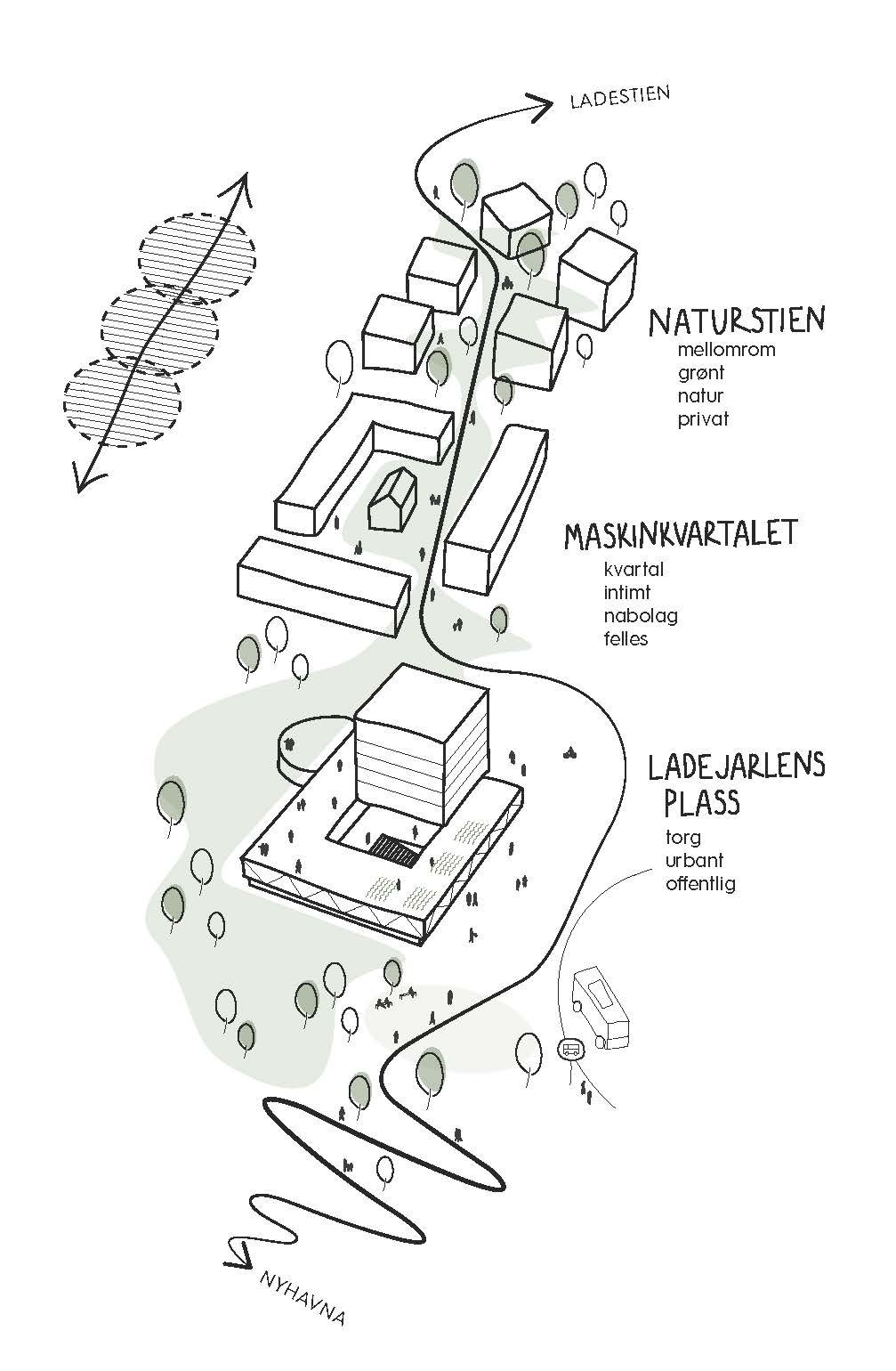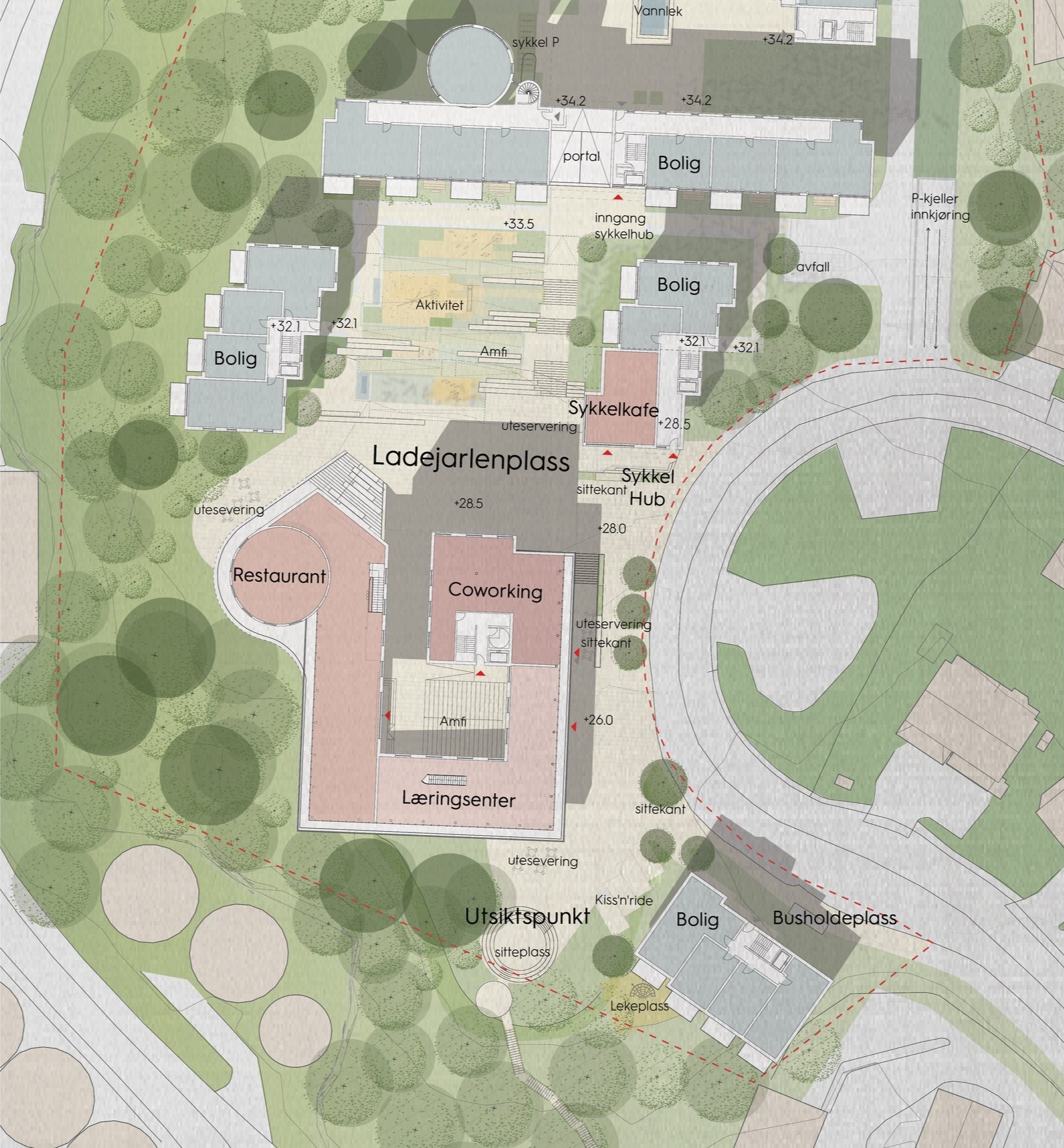
Ladehammeren
Urban renewal of a maritime college in the Trondheim harbour area
TYPE OF PROJECT: Transformation, Housing, Landscape
LOCATION: Ladehammeren, Trondheim, Norway
CLIENT: Ladehammeren AS COLLABORATORS: JSTA
SIZE: ca. 24 000 m²
PROJECT STATUS: Competition proposal
Ladehammeren stands out in Trondheim for its unique combination of fjord views, sunshine to the west, and a stunning south-facing panorama of the city center. Positioned as a natural extension of downtown, it boasts potential for vibrant urban life and proximity to the scenic Ladestien trail and Trondheimsfjord, offering a serene yet connected living experience. While many recognize the iconic brick building on the hill, its secluded setup and challenging topography leads to limited accessibility. As Trondheim expands, reimagining this space could unlock its value for broader enjoyment.
Envisioning Ladehammeren as the urban crown jewel of Trondheim's northeast, we propose a respectful and sustainable transformation. By revitalizing and adding buildings, creating communal spaces, and enhancing the landscape, Ladehammeren is set to become a dynamic destination for living, working, and leisure in the city's future.
The Urban Fabric
The site is opened towards the fjord, offering views, breaking down scale, and enabling a route through the area, creating three unique neighborhoods with diverse characters. These areas aim to be vibrant meeting spots, transitioning from urban to rural settings, while integrating Ladejarlen's historical elements.
A diverse set of housing options is introduced, ranging from compact apartments to terraced houses. Existing structures will be transformed to unique apartments unlike any in Trondheim. Distinct neighborhoods are designed to accommodate people at various life stages. The outdoor spaces, accessible to residents and visitors alike, will seamlessly integrate with the stunning natural surroundings.
Living in Ladehammeren will breathe life into the area throughout the day, enhancing safety and social interaction for both locals and visitors. A larger residential population also bolsters the local economy, supporting businesses and attractions that benefit the broader community.
«Transformation of existing building structures are an integral part of sustainable urban renewal. At Ladehammeren our concept was a simple and straightforward strategy to re-use and reprogram the existing school buildings on site, creating new neighborhood identities around a defined set of public outdoor spaces. Sustainable energy solutions, combined with active re-use of materials resulted in a pragmatic and site sensitive architectural response that also actively integrated the natural coastal landscape flora into the urban fabric of this site, in close proximity to the harbour area of Trondheim.»
Partner at A-lab, Erik Olav Marstein
Three different urban spaces with different character and functional mix form sequences of unique neighbourhoods, which connect and create a strong link between the city in the south and nature in the north.
Ladejarlens plass
The urban and open neighborhood.
The area from Nyhavna to Ladejarlens Plass is transformed into a dynamic urban center, blending public amenities with both new and refurbished structures to create a vibrant community hub. The project promises panoramic city and fjord views and acts as a gateway to various neighborhoods, integrating residential and natural spaces. Central to the redevelopment is the adaptive reuse of the iconic main building, which includes a tower block and restaurant, enhancing its historical and aesthetic appeal by opening up its structure and repurposing its roof as a public attraction. The demolition of old school buildings between Buildings A and B makes way for a multi-level urban space designed for community gatherings and events, enriched by daylight and fjord vistas.
Further enhancements include the extension of the circular pavilion’s arch, integrating it with an outdoor staircase, and maintaining the west-facing restaurant's panoramic views, now accessible to the public. The tower block is set for an upgrade, adding a floor to create a multifunctional space with housing options. The main building’s transformation into a learning center emphasizes food, cultivation, and nature, complemented by co-working spaces, a grocery store, and specialty shops to reduce transport needs. Rooftop and nearby public spaces are designed to distinguish between private and public areas, fostering a cohesive community environment.
Maskinkvartalet
The intimate neighborhood.
Maskinkvartalet is envisioned as a unique and intimate urban neighborhood, integrated into the existing fabric of buildings B, C, and D. By opening up the neighborhood and establishing free passage from north to south and east to west, the project ensures seamless integration with the surrounding spaces. A sunny and inviting courtyard is created at its heart, surrounded by diverse housing types, from studio flats to terraced houses. The strategy includes densifying the building structure around the courtyard while preserving the architectural footprint and height of Building B as much as possible. This approach not only respects the neighborhood's historical and cultural significance but also promotes a varied living environment.
The project proposes to reuse or adapt existing structures and roofs, in collaboration with conservation authorities. Buildings within Maskinkvartalet, such as Maskinhallen (Building D) and Paviljongbygningen (Building B), will undergo transformations to serve new functions while enhancing the narrative of the space. Maskinhallen is set to become a cultural hub, offering flexible spaces for community events, while Paviljongbygningen will be converted into an apartment complex, adding a distinctive character to the neighborhood. Building C's transformation into terraced houses and apartments aims to maintain a coherent streetscape, contributing to the overall vibrancy and appeal of Maskinkvartalet as a living, breathing part of the city.
Naturstien
Neighborhoord on the terms of nature.
The residential placement respects the natural terrain and vegetation, with strategic setbacks to the east to preserve the lush, green edge to the west. Efforts include organizing natural ground cover and additional planting, with a minimal extent for the underground parking to allow vegetation to flourish. The design propose the parking to end at Maskinkvartalet, but allows for potential future extension.
In the northeastern part of the plateau, the proposal includes the demolition of Buildings E and F to make way for new, detached tower blocks as residential units. These buildings will vary in height and orientation to ensure optimal daylight and views for the residences and surrounding outdoor areas, integrating green spaces and re-establishing natural elements around the development. The design connects the area with Ladehammerstien and the broader cultural landscape through paths and bridges, featuring amenities like shelters, play areas, and a picnic zone that offers shelter against the elements, encouraging outdoor activities and enjoyment of the scenery.
Cultural history documentation carried out by Norconsult has evaluated building F as not having conservation status. Building E has been evaluated as having a more secluded, independent location at the rear of the facility. This led to the decision to remove Buildings E and F, prioritizing natural design principles to protect the cultural landscape and support biodiversity. The staggered positioning of the tower blocks maximizes sunlight and views, with the flexibility in design for different apartment spans and heights adjusted to blend with the surrounding environment. Apartments feature private balconies and communal outdoor spaces that engage directly with the natural setting, promoting a lifestyle deeply connected to the landscape.
Surrounding vegetation creates secluded areas and is integral to the site's character, especially where new buildings meet the forest, preserving significant trees and reintroducing native plants.

Sustainability
The project takes a holistic and systemic approach to sustainability, endeavouring to have a regenerative impact on technical, ecological and social systems.
ESG Strategy
ESG reporting provides stakeholders with information about commitment to sustainable practices, corporate social responsibility and ethical governance. The project is designed in accordance with the 17 UN Sustainable Development Goals (SDGs) that can link the sustainability strategy with actions in the project to support ESG reporting (see illustration to the right).
The sustainability strategy can be presented in the ESG format as follows:
1. Environmental Impact:
Sustainable design: Use of low-emission building materials, reuse and recycling solutions, energy efficient systems, renewable energy and water saving strategies in the project (SDG 9. Innovation and infrastructure, 11. Sustainable cities and communities, 12. Responsible consumption and production)
Waste management: Waste management strategies, including recycling programmes, waste reduction measures and responsible disposal during the construction and operation phases.
Green transport: Alternatives to cars such as cycling, walking and public transport. Provide adequate infrastructure, such as cycle lanes and charging stations for electric bicycles and vehicles (SDG 11. Sustainable cities and communities).
2. Social Considerations:
Housing diversity: The provision of diverse housing solutions that address the need for inclusive communities and contribute to (SDG 11: Sustainable cities and communities).
Social infrastructure: Shared facilities such as parks, playgrounds, community centres and recreational facilities to promote social interaction and a sense of community (SDG 3. Good health and quality of life, 11: Sustainable cities and communities).
Accessibility: Good accessibility is incorporated into project and surrounding infrastructure to ensure adaptation to the needs of all user groups (SDG 10: Reduced inequalities).
3. Governance and Ethical Considerations:
Transparency: Information on the project's governance structure, decision-making processes and stakeholder involvement to demonstrate commitment to transparency and accountability.
Ethical sourcing: Responsible procurement practices for building materials, ensuring compliance with environmental and social standards throughout the supply chain.
Certifications: Go beyond technical regulations to verify sustainability initiatives with relevant certification systems and sustainability standards, such as BREEAM-Nor or similar.
Construction Phases

































